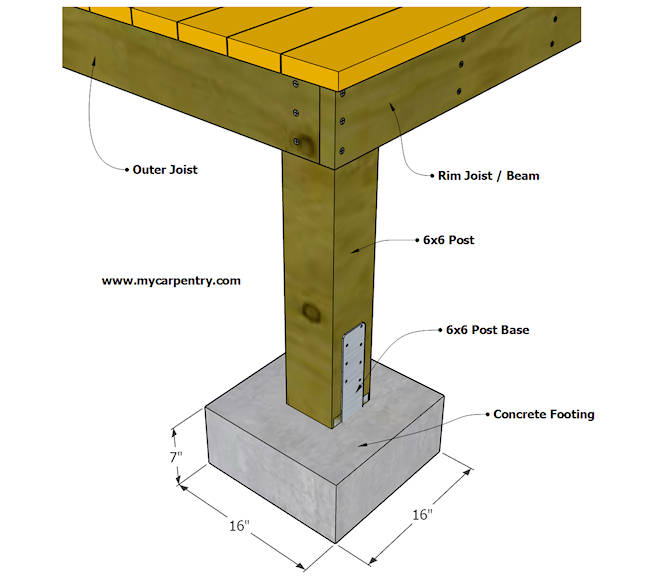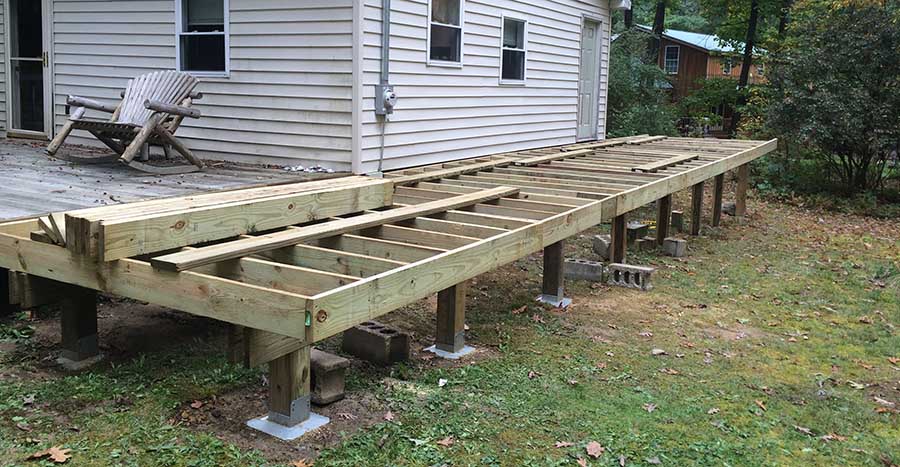Take Full Advantage Of the Life Expectancy of Your Deck With Reliable and Solid Footings
In order to fully optimize the life expectancy of your deck, it is critical to make sure that it is developed on solid and dependable grounds. These grounds develop the structure of your deck, supplying stability and assistance, and are frequently the difference between a deck that lasts for years and one that requires continuous fixings. In this conversation, we will explore the relevance of trustworthy footings, the different kinds of strong ground materials, appropriate installment techniques, and just how to preserve and examine your deck's footings to stop damages.
Significance of Reliable Grounds
When it comes to making the most of the life expectancy of your deck,The value of reliable footings can not be overemphasized. The footings act as the foundation whereupon the entire structure relaxes, providing security and support. Without a strong footing, the deck is vulnerable to shifting, sinking, and even collapse, which can significantly lower its lifespan and pose safety and security risks.

Choosing the appropriate type of ground is additionally crucial. The most common types consist of concrete grounds, helical piers, and sonotubes. Elements such as dirt problems, climate, and the dimension of the deck will certainly establish the most ideal choice. Hiring an expert to examine the dirt, design the footings, and guarantee appropriate installment is highly suggested.
Purchasing dependable grounds might include extra price and effort upfront, however it is a worthwhile investment that will add to the long-term toughness and safety and security of your deck. By making certain a strong foundation, you can appreciate your deck for several years ahead, knowing that it is constructed to hold up against the test of time.
Kinds Of Solid Ground Materials
To make certain the security and longevity of your deck, it is necessary to take into consideration the various kinds of strong ground materials readily available. The selection of footing material is vital as it supplies the necessary support and stability to hold up against the weight and lots of the deck framework.
One usual and dependable material used for deck grounds is concrete. Concrete footings are durable and provide outstanding stability.
For locations with poor dirt problems, such as expansive or loose dirts, a ground system that makes use of steel or composite piers may be favored. Deck Footings. These piers are driven deep into the ground to get to secure soil layers, making certain the stability of the deck
In some situations, deck grounds can also be built making use of treated lumber. Nevertheless, it is essential to guarantee that the lumber is effectively treated to withstand rot and degeneration created by exposure to wetness and pests.
When picking a footing product for your deck, it is critical to think about aspects such as soil conditions, climate, and neighborhood building codes. Consulting with a professional specialist or architectural designer can help establish one of the most ideal ground material for your particular deck job.
Proper Installation Methods for Footings
Considering the significance of guaranteeing stability and resilience read what he said for your deck, it is necessary to understand the appropriate setup methods for footings. The success of your deck job relies greatly on the stability of its foundation, which is why following the right installation techniques is crucial.
Most importantly, it is required to figure out the suitable dimension and deepness of the grounds based on the style and load demands of your deck. This details can be obtained from developing codes or with appointment with an architectural engineer. As a general rule, footings need to go to least 12 inches in size and expand below the frost line to stop shifting or resolving.
Once the measurements are established, the following step is excavation. Digging the holes for the grounds ought to be done with accuracy, making certain they are deep enough and have a degree bottom. Deck Footings. This will certainly supply a steady base for the footings
To better improve the stability of the grounds, it is advised to utilize a concrete combine with a strength of at the very least 3,000 psi. This will certainly ensure the grounds can hold up against the weight and pressures put in by the deck.
Throughout installation, it is necessary to keep the grounds degree and straightened correctly. This can be attained by using a degree and string lines to lead the positioning of each ground.
Preserving and Examining Your Deck's Footings
Regular upkeep and detailed evaluations are vital for guaranteeing the long-term stability and security of your deck's grounds. With time, grounds can succumb to deterioration, weather condition conditions, and dirt activity, which can endanger their structural honesty. To make best use of the lifespan of your deck's footings, it is important to apply a regular maintenance routine and carry out detailed inspections.

In addition, it is essential to examine grounds for any type of indications of damages or deterioration. This includes checking for cracks, splits, or crumbling concrete, along with any indicators of motion or negotiation. Any kind of problems should be dealt with quickly to avoid additional damage and guarantee the stability of the deck.
Additionally, it is advised to examine the bordering dirt for any indicators of disintegration or moving. Dirt activity can affect the stability of the footings, so it is important to deal with any type of soil-related concerns promptly.
Signs of Footing Damage and Exactly How to Address Them
Footing damage can present significant risks to the stability and safety of your deck, making it necessary to without delay recognize and address any signs of damage. Among one of the most common signs of footing damage is sinking or resolving of the deck. This can take place due to dirt erosion, inadequate footings, or poor building methods. If you see that your deck is uneven or leaning, it is essential to take instant activity to avoid additional damages. Another indicator of footing damage is crumbling or fracturing of the concrete footings. This can be triggered by freeze-thaw cycles, excessive dampness, or low quality concrete. If you observe why not look here any type of cracks or damage in the footings, it is essential to have them checked and repaired by an expert. Furthermore, read this post here if you see any movement or changing of the deck, such as a deck that really feels unpredictable when walked on or wobbles when weight is applied, maybe an indication of footing damages. In such cases, it is recommended to speak with a specialist contractor or a structural designer to evaluate the extent of the damages and establish the appropriate strategy. Keep in mind, dealing with ground damages quickly can aid make sure the long-lasting stability and safety and security of your deck.
Conclusion
In final thought, guaranteeing the reliability and strength of footings is essential for taking full advantage of the life expectancy of your deck. By using strong ground products and appropriately mounting them, you can stop damage and maintain the stability of your deck.
These grounds create the structure of your deck, offering stability and assistance, and are usually the distinction between a deck that lasts for decades and one that requires continuous repair work. In this discussion, we will certainly check out the significance of reputable footings, the various kinds of strong footing products, appropriate installation strategies, and just how to preserve and inspect your deck's grounds to protect against damage.Regular maintenance and thorough inspections are important for ensuring the lasting stability and safety and security of your deck's grounds. Keep in mind, dealing with footing damages promptly can help make certain the long-lasting stability and security of your deck.
By using solid ground materials and effectively installing them, you can protect against damage and keep the stability of your deck.